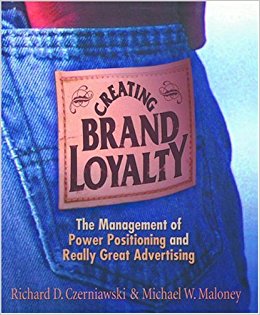 The Management of Power Positioning and Really Great Advertising
The Management of Power Positioning and Really Great Advertising
At the end of the day, the relationship you nurture with your customers defines your brand — It’s a two-way street.
We summarize the traits a successful marketer needs to possess, to impose its brand on the targeted audience.
Who Should Read “Creating Brand Loyalty”? And Why?
Is it been too long since you came across an eye-catching book that you wished to read it several times? If not, perhaps you will. A fact-filled, easily digestible content is not easily accessible. Nevertheless “Creating Brand Loyalty” enables its readers to dive deep into the “marketing” waters by stimulating free-flowing ideas.
This book doesn’t underestimate the fundamental marketing techniques. However, the emphasis lies on new strategic requirements associated with creating brand-loyalty processes. We without any hesitation recommend this book to senior managers, marketing experts, students, academics, etc.
About Richard D. Czerniawski & Michael W. Maloney
 The authors Richard D. Czerniawski and Michael W. Maloney are working at a marketing-consulting company known as Business Development Network as managing directors.
The authors Richard D. Czerniawski and Michael W. Maloney are working at a marketing-consulting company known as Business Development Network as managing directors.
Despite their brand-building orientation, the firm also offers Strategic Positioning and Ad College services.
Fortune’s 500 companies have raised their voice about the effectiveness of these marketing programs.
“Creating Brand Loyalty Summary”
Just like the artists have a specific way of perceiving nature, marketers guided by the same logic, have named today’s era as the “age of sameness”. Not even an abundance of choices ultimately means successful product differentiation.
For example, if you are working in/ owning a restaurant, and right next to you there is another one, preparing the same kind of food as you are, what would you do or how would you handle the “sameness”? Whether we like it or not, businessmen in some industries have little space for maneuvering.
Eventually, the society will take these signs with utmost care, and affect the brand-creating process. Product differentiation just like any other process relies on ingenuity, expertise, inventiveness, dedication, and commitment towards excellence.
Financial departments and marketing organizations meet on controversial and still unknown grounds to discuss the cost/benefit ratio. It’s equally important to mention the lack of flexibility since many companies have continued walking on the same unprofitable path due to stubborn reasons.
The approach that firms use to improve their market positioning, or increase sales can sometimes be the cause of lack of differentiation. Then again, think of it this way – Why would any potential buyer, prefer my product and how to convince them?
In case you didn’t notice, brands are affected in two unique ways. Nowadays, switching from product to product, or from first-class to substitute is just like drinking coffee. So, in the first place, we put the eroded customer loyalty. It’s just good sense to look for an improved version of your previously used commodity. However, brands would prefer that you stick with their offer, and they’ll try to make you a loyal customer.
This theory slowly leads us to step No. 2. The loyalty collapse gave the companies little room for focusing on product improvements. The primary goal or focus was placed on inventiveness and creativity – referring to coming up with all sorts of promotion offers.
The new era has created a price-orientated marketplace, as a result of consumers’ needs. Generally speaking, this erosion challenged all entrepreneurs to adopt the unique globalization perspective to increase profits. To overturn these modern trends, companies are nowadays paying extra attention to create a special bond and built a long-term relationship with their most trusted customers.
The problem lies in product differentiation; many owners will turn to the old-fashioned price-war without even trying something more inventive. This book uncovers series of mind-blowing tactics that will entice the readers to notice your product.
Increasing brand awareness and brand loyalty take years of service, but only seconds the other way around. One of the tactics you can use is to go beyond the essential tangible features of the product and introduce the audience to some of the intangible elements.
Given these points, highly capable marketers lean heavily forward by trying to exploit some of the opportunities. The trick is to make your customers feel addicted to your commodities.
According to societally imposed opinions, eagerness for learning and thirstiness for knowledge are the most critical ingredients in the “success” recipe. What is knowledge, absent decision-making? If you have the biggest castle in the world, you’ll not be happy if you don’t have that special person right beside you.
Don’t take these social constraints too seriously; there is something way more significant than knowledge – a vision. Transform your mindset, from knowledge seeker to risk-taker and vision-maker.
Key Lessons from “Creating Brand Loyalty”
1. The power of a statement
2. Brand Positioning
3. How to reach the customers
2. Brand Positioning
3. How to reach the customers
The power of a statement
Power positioning is a process covered in this book, which indicates the significance of remodeling the brand-positioning declaration into a blueprint.
Power positioning is energetically protecting the statement by ensuring that everything your company does, manifests the vision encapsulated in the report.
Brand Positioning
Positioning is not a part-time job. As an illustration of the influence that positioning has over overall success, the authors present several irreplaceable elements in the brand-building process.
All of them focus on “sound strategic marketing, promotion techniques, and designing ads.
Understanding customer needs, targeting a specific customer group, evaluating long-term benefits, creating a competitive framework are some of the elements crucial for successful brand-positioning.
How to reach the customers
Reaching the target customer group or IBP can be as complicated as the entire manufacturing process.
Before you start chasing them, you need to define – who are you targeting and why.
This simple method will help you sneak into the minds of the customers – knowing their thoughts is everything.
Like this summary? We’d Like to invite you to download our free 12 min app, for more amazing summaries and audiobooks.
“Creating Brand Loyalty” Quotes
Once you’re satisfied that you have a viable brand positioning, put it to the test by comparing it to your competitors’ inferred positioning.The benefit is the payoff to the customer.Positioning is a full time job.Like music, the basic principles for brand development and great advertising are the same worldwide.Understanding, developing and evolving - even creating - customer needs is at the core of every successful business venture.Our Critical Review
Creating Brand Loyalty has never been more delicate, but doesn’t have to discourage you, take it as a challenge.
The authors Richard D. Czerniawski and Michael W. Maloney produced this entrepreneurial guide which covers subjects far more complex than marketing – targeting marketing professionals, and other ordinary people.

0 comments:
Post a Comment
Note: only a member of this blog may post a comment.